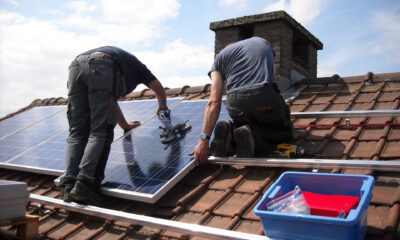
OpEds

SA’s green-energy transition obscured by potholes
Global warming and climate change have become a conversation staple, especially over the past decade. We have already experienced first-hand the effects in South Africa and around the world. Over the past few years, South Africans have witnessed extreme heat waves, devastating floods, even mild earthquakes.
The number of natural disasters in the world increased 71% in the past 20 years, and a staggering 950% since the 1960s, with experts predicting exponential increases in the future. There’s absolutely no doubt that if we’re to have any hope of curbing these alarming disasters, more needs to be done, and with a real sense of urgency.
Though South Africa is by no means a primary culprit in global greenhouse gas emissions, we’re a country that has a heavy reliance on coal for energy generation. Considering the fact that generation of energy accounts for more than 70% of global greenhouse gases, this is something that needs to be at the foreground of this discussion.
In addition to energy generation, South Africa plays host to some of the world’s greatest polluting companies, particularly in the mining space.
With all this in mind, the most obvious questions are: what are we doing to stem the flow of greenhouse gases emitted in South Africa? And what more can be done?
This complex debate can be broken down into two main areas: actions taken by the government, and actions taken by the private sector.
For a bit of context, “net-zero” refers to a global target – set in the Paris Climate Accords – for the amount of carbon emitted into the atmosphere to be equal to the amount being absorbed or removed. According to global benchmarking, South Africa is rated as having an “insufficient” approach toward net-zero targets. This rating is attributed to the combination of our government’s internationally supported targets, and policies being implemented to achieve these targets.
The good news is that recently, we have witnessed a far more urgent push towards a renewable energy transition. Regardless of the fact that this is mostly coming from a desperate need to supplement our frail energy grid, it’s still encouraging to see the government removing red tape in the development of green energy projects and offering tax incentives for companies to pursue these projects.
Another shining light is that our president recently identified the enormous opportunities which lie in developing a green hydrogen sector in South Africa. Hydrogen is an extremely effective fuel source which produces water as its only emission. It’s crazy, I know.
Up until recently, it has been relatively expensive to produce cleanly, and has had a limited market, but that’s changing rapidly. With improving technology and costs starting to come down significantly, more and more countries have identified hydrogen as their chosen fuel of the future.
Geographically, South Africa is regarded as one of the three best countries in the world to generate and export green hydrogen, so it’s exciting to see that the government is taking steps towards exploiting this potential.
Unfortunately, there are still a couple of major areas of concern. Transport is another major contributor to greenhouse gas emissions, and with South Africa’s rail infrastructure close to non-existent, the transport of people, materials, livestock, and freight is largely carried out by trucks and buses – notorious for being heavy pollutants.
Another is that recently, the department of mineral resources and energy has been making statements which allude to the fact that it would like to put more of its focus on maintaining and developing coal power stations rather than the shift towards renewables.
Now onto the private sector. The shift we’re seeing towards a greener private sector is quite an interesting one. I already mentioned government incentives for companies to pursue renewable energy projects, however these are fairly insignificant in comparison to global standards. That being said, there has recently been an explosion of renewable energy projects among some of the biggest entities in South Africa.
Our fragile electrical grid means that companies are at a point where they don’t really have any option but to produce at least a portion of their own power just to stay operational. Solar energy combined with battery backup systems has traditionally been an expensive alternative to consider. However, when you factor in the cost of running diesel generators for a third of the day as well as losses due to downtime, exploration of these solutions isn’t just cost effective, it’s almost imperative. This is the primary reason for such an uptick in these green energy projects.
Large international companies have major operations in South Africa, particularly in the mining and automotive sectors. And though South Africa may have relatively slack emission standards and policies, these companies don’t. Most of their global headquarters are pushing them to reduce their carbon footprint around the world. Notably, one of the largest mining companies in the world has developed a 300-ton truck powered solely by hydrogen which is in operation in Limpopo.
To wrap up, though elements of the South African government’s strategy and roadmap provide excitement about the country’s decarbonisation and renewable energy transition, I would like to see a lot more. In order for us to be in line with global net-zero targets, we need to have a more robust commitment to shift energy generation, transportation, agriculture – as well as many other key sectors – towards a greener future.
With shifts in policy within state-owned enterprises, a focus on exciting green opportunities, as well as incentives and penalties in the private sector, South Africa has the potential to be a key player in a greener future on a global scale.
- Erin Berman-Levy is an industrial engineer and chief executive of Blue Echo Energy, a company that specialises in providing innovative renewable energy solutions.











Michael Rosenberg
February 9, 2023 at 7:59 pm
“Global warming and climate change have become a conversation staple” – You seem to have missed the memo. First it was global cooling then Ozone then global warming these narratives have all failed. Its Climate-Change, and only climate-change. How do you expect us to accept the bullcrap if you can’t get the narrative straight. Please this is the last time I want to correct you and your propaganda